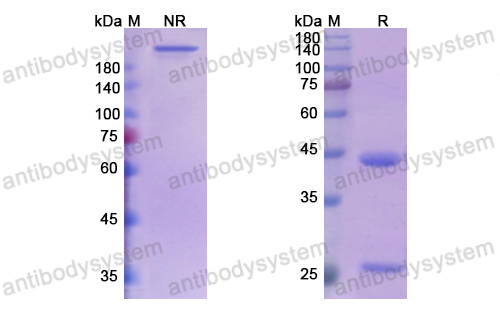Catalog No.
DHB99001
Expression system
Mammalian Cells
Species reactivity
Human
Host species
Humanized
Isotype
IgG1-Kappa
Clonality
Monoclonal
Target
APOC3, Apolipoprotein C3, Apo-CIII, Apolipoprotein C-III, ApoC-III
Concentration
1 mg/ml
Endotoxin level
Please contact with the lab for this information.
Purity
>95% as determined by SDS-PAGE.
Purification
Protein A/G purified from cell culture supernatant.
Accession
P02656
Applications
Research Grade Biosimilar
Form
Liquid
Storage buffer
0.01M PBS, pH 7.4.
Stability and Storage
Use a manual defrost freezer and avoid repeated freeze-thaw cycles. Store at 4°C short term (1-2 weeks). Store at -20°C 12 months. Store at -80°C long term.
Alternative Names
ARGX-116
Clone ID
STT-5058
Robust Serum Proteomic Signatures of APOE2., PMID:40501769
Genetics of remnant cholesterol., PMID:40277396
Familial chylomicronemia syndrome and treatments to target hepatic APOC3 mRNA., PMID:40068508
Molecular Therapeutics in Development to Treat Hyperlipoproteinemia., PMID:39875700
An up-to-date review of emerging biologic therapies for hypercholesterolemia., PMID:39668448
New drugs for treating dyslipidemias. From small molecules to small interfering RNAs., PMID:39645293
Advances in nucleic acid-targeted therapies for cardiovascular disease prevention., PMID:38970537
Advances in Dyslipidaemia Treatments: Focusing on ApoC3 and ANGPTL3 Inhibitors., PMID:38299167
The analysis of serum lipids profile in Guillain-Barre syndrome., PMID:38143756
Inhibition of Angiopoietin-Like Protein 3 or 3/8 Complex and ApoC-III in Severe Hypertriglyceridemia., PMID:38095804
Exploring apolipoprotein C-III: pathophysiological and pharmacological relevance., PMID:38039351
Apolipoprotein C3 induces inflammasome activation only in its delipidated form., PMID:36781985
Gene editing for dyslipidemias: New tools to "cut" lipids., PMID:36725417
Broadening the Scope of Dyslipidemia Therapy by Targeting APOC3 (Apolipoprotein C3) and ANGPTL3 (Angiopoietin-Like Protein 3)., PMID:36579649
ENO1 Binds to ApoC3 and Impairs the Proliferation of T Cells via IL-8/STAT3 Pathway in OSCC., PMID:36361568
New, Novel Lipid-Lowering Agents for Reducing Cardiovascular Risk: Beyond Statins., PMID:35929170
Plasma Proteome Profiling of Patients With In-stent Restenosis by Tandem Mass Tag-Based Quantitative Proteomics Approach., PMID:35265678
Addressing dyslipidemic risk beyond LDL-cholesterol., PMID:34981790
High-resolution serum proteome trajectories in COVID-19 reveal patient-specific seroconversion., PMID:34232570
ANGPTL3 and Apolipoprotein C-III as Novel Lipid-Lowering Targets., PMID:33694000
New Trends in Dyslipidemia Treatment., PMID:33177309
Lipid-Lowering Biotechnological Drugs: from Monoclonal Antibodies to Antisense Therapies-a Clinical Perspective., PMID:32997212
Nucleic Acid-Based Therapies for Atherosclerosis., PMID:32034521
Emerging Evidence that ApoC-III Inhibitors Provide Novel Options to Reduce the Residual CVD., PMID:31111320
Pharmacological treatment options for severe hypertriglyceridemia and familial chylomicronemia syndrome., PMID:29842811
A human APOC3 missense variant and monoclonal antibody accelerate apoC-III clearance and lower triglyceride-rich lipoprotein levels., PMID:28825717
A decade of progress on the genetic basis of coronary artery disease. Practical insights for the internist., PMID:28395986
Plasma-derived Extracellular Vesicles Contain Predictive Biomarkers and Potential Therapeutic Targets for Myocardial Ischemic (MI) Injury., PMID:27234505
Identification of potential bladder cancer markers in urine by abundant-protein depletion coupled with quantitative proteomics., PMID:23631828
Genes of the immune system cosegregate with the age at onset of diabetes in the BB/OK rat., PMID:9446818
Evaluation of double filtration plasmapheresis, thermofiltration, and low-density lipoprotein adsorptive methods by crossover test in the treatment of familial hypercholesterolemia patients., PMID:8860710

